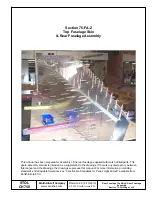
B. Precautions
Regular maintenance must be accomplished per this manual and per the applicable
aircraft and/or engine service manuals and publications. In addition, observe the following
precautions:
(1) DISCONNECT THE BATTERY before connecting or disconnecting test instruments (except voltmeter),
or before removing or replacing any unit or wiring. Accidental grounding or shorting at the regulator,
alternator, ammeter or accessories, will cause severe damage to the units and/or wiring.
(2) (2) DO NOT REMOVE THE OUTPUT LEAD. The output lead must not be removed from the alternator
while the rotor winding is energized and the alternator is operating.
(3) (3) DO NOT ATTEMPT TO POLARIZE THE ALTERNATOR. For alternator model ES-10024B-5 or -5LS,
refer to section 5.4 for “Alternator Self Excitation Test”.
(4) (4) DO NOT GROUND THE OUTPUT TERMINAL. Grounding of the alternator output terminal may
damage the alternator and/or aircraft electrical circuit.
(5) (5) DO NOT REVERSE BATTERY CONNECTIONS. Reversed battery connections may damage the
rectifiers, aircraft wiring or other components of the charging system. Battery polarity should be checked
with a voltmeter before connecting the battery.
(6) (6) ASSURE PROPER CONNECTIONS TO THE BATTERY. If a booster-battery or fast-charger is used,
its polarity must be connected correctly to prevent damage to the electrical system components.
5.2 Inspection
A. Arc Marks on Terminals (Visual Inspection):
(1) Before removing the alternator, the threads and each terminal stud should be inspected for signs of
arcing.
(2) Arc marks are usually caused by a loose wire terminal connection resulting from failure to tighten the
attaching nut.
(3) Arc marks can also be caused by improper service techniques that permit wires to be connected and
disconnected while current is flowing. A loose connection at the alternator output (battery) terminal can
erode completely through the terminal stud over time.
(4) Diode damage can occur because of the inductive voltage spikes generated by the make and break
of loose terminal connections. The positive and negative rectifiers must be replaced at next alternator
overhaul.
(5) Voltage regulator and mechanical field relay damage can also be expected due to the chattering
contacts each time the loose connection makes or breaks. Chattering contacts that are excessive will
result in rapid contact erosion.
(6) Solid state field relays will not be damaged, however they may generate electrical noise.
B. Bearing Inspection (For Troubleshooting Purposes):
(1) A simple bearing test should be performed regardless of the reason for alternator removal from the
engine. This may be done on or off the engine. The purpose of the test is to determine if either of the
bearings are a potential for noise or failure.
(2) To perform a test for worn bearings, disengage the belt or hold the alternator in one hand and snap-spin
the shaft/pulley with the other. A worn bearing will be heard or felt. Snap-spin the shaft/pulley a few times
to verify.
Aircraft Alternator
Maintenance Manual
24-30-01
ES1031
Page: 5-2 Rev.
B: 20 Apr. 2022
© 2022 - Hartzell Engine Technologies - All rights reserved
















































